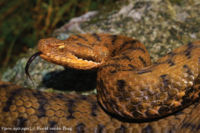| Viperidae | ||||||||||||||
|---|---|---|---|---|---|---|---|---|---|---|---|---|---|---|

Asp viper,
Vipera aspis
|
||||||||||||||
| Scientific classification | ||||||||||||||
|
||||||||||||||
|
The Viperidae are a family of venomous snakes commonly referred to as vipers, although the term viperids is more specific and distinguishes them from the viperines (subfamily Viperinae). These snakes are found all over the world, except in Australia and Madagascar. All have relatively long, hinged fangs that permit deep penetration and injection of venom. Four subfamilies are currently recognized.[2]
Contents |
Description
All viperids have a pair of relatively long, solenoglyphous (hollow) fangs, that are used to inject venom from glands located towards the rear of the upper jaws. Each of the two fangs is located at the front of the mouth on a short maxillary bone that can rotate back and forth. When not in use, the fangs fold back against the roof of the mouth and are enclosed in a membranous sheath. The left and right fangs can be rotated together or independently. During a strike, the mouth can open nearly 180 degrees and the maxilla rotates forward, erecting the fang. The jaws close on impact and powerful muscles that surround the venom glands contract to inject the venom as the fangs penetrate. This action is lightning-fast and is more a stab than a bite. Viperids use this mechanism both to immobilize their prey and in self-defense.
Almost all vipers have keeled scales, a stocky build with a short tail and, due to the location of the venom glands, a triangular-shaped head distinct from the neck. Their eyes have vertically elliptical, or slit-shaped, pupils that can open wide to cover most of the eye or close almost completely, which helps them to see in a wide range of light levels. Typically, vipers are nocturnal, ambush predators.
Compared to many other snakes, vipers often appear rather sluggish. Most are ovoviviparous, giving birth to live young, but a few lay eggs. Indeed, the name of this group is derived from Latin (vivo = live, parthus = birth) and is in reference to the more common of these two reproductive modes.[3]
Venom
As opposed to the elapids, which produce mainly neurotoxic venom, viperid venoms are largely proteolytic, meaning that they rapidly destroy blood and tissue. This kind of venom is also dual-purpose. Most vipers have poor digestive systems and often rely on their venom not just to immobilize their prey, but also to aid in the digestion thereof: fluids in the stomach digest the meal from the outside in, while the venom digests it from the inside out.
There are, of course, always exceptions and a number of viperid species produce venom that is partially or even entirely neurotoxic, which can make them extremely dangerous. Examples are the tropical rattlesnakes (Crotalus durissus), some Mojave rattlesnakes (Crotalus scutulatus), and the rare mountain adder (Bitis atropos).
Due to the nature of proteolytic venom, a viperid bite is often a very painful experience and should always be taken seriously, even though it is not necessarily fatal. Even with prompt and proper treatment, a bite can still result in a permanent scar, and in the worst cases the affected limb may even have to be amputated. A victim's actual fate is impossible to predict as this depends on many factors, including (but not limited to) the species and size of the snake involved, how much venom was injected (if any) and the size and condition of the patient prior to being bitten. The patient may also be allergic to the venom and/or the antivenin.
Subfamilies
| Subfamily[2] | Authority[2] | Genera[2] | Species[2] | Common name | Geographic range[1] |
|---|---|---|---|---|---|
| Azemiopinae | Liem, Marx & Rabb, 1971 | 1 | 1 | Fea's viper | Myanmar, southeastern Tibet across southern China (Fujien,Guangxi,Jiangxi,Kweichow,Sichuan,Yunnan,Zhejiang) to northern Vietnam. |
| Causinae | Cope, 1859 | 1 | 6 | Night adders | Subsaharan Africa |
| Crotalinae | Oppel, 1811 | 18 | 151 | Pit vipers | In the Old World from eastern Europe eastward through Asia to Japan, Taiwan, Indonesia, peninsular India and Sri Lanka. In the New World from southern Canada southward through Mexico and Central America to southern South America. |
| Viperinae | Oppel, 1811 | 12 | 66 | True or pitless vipers | Europe, Asia and Africa. |
Type genus = Vipera - Laurenti, 1768[1]
Taxonomy
That Viperidae is attributed to Oppel (1811), as opposed to Laurenti (1768) or Gray (1825), is subject to some interpretation. However, the consensus among leading experts is that Laurenti used viperae as the plural form of vipera (Latin for viper, adder or snake) and did not intend for it to indicate a a family group taxon. Rather, it is attributed to Oppel, based on his Viperini as a distinct family group name, despite the fact that Gray was the first to use the form Viperinae.[1]
Cited references
- ^ a b c d McDiarmid RW, Campbell JA, Touré T. 1999. Snake Species of the World: A Taxonomic and Geographic Reference, vol. 1. Herpetologists' League. 511 pp. ISBN 1-893777-00-6 (series). ISBN 1-893777-01-4 (volume).
- ^ a b c d e Viperidae (TSN 174294). Integrated Taxonomic Information System. Accessed on 10 August 2006.
- ^ Schuett GW, Höggren M, Douglas ME, Greene HW. 2002. Biology of the Vipers. Eagle Mountain Publishing, LC. 580 pp. 16 plates. ISBN 0-9720154-0-X.
External links
- Family Viperidae at EMBL Reptile Database. Accessed 27 October 2006.
- Family Viperidae at Animal Diversity Web. Accessed 27 October 2006.